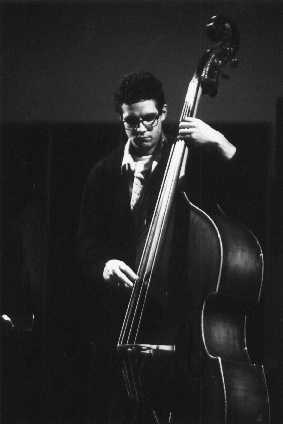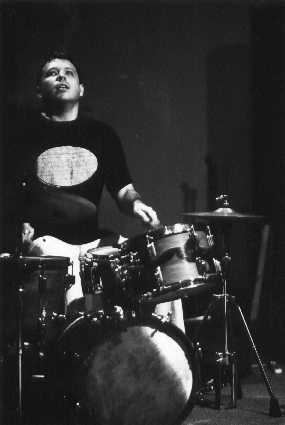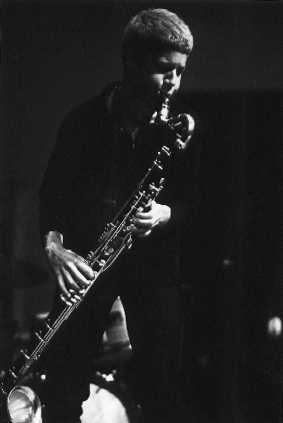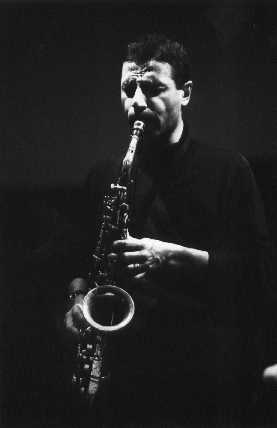Organizing Improvisers: Vancouver Time Flies
Article and Photography by Laurence SvirchevThe concept of the 11th Annual Vancouver "Time Flies" was simple and intriguing: take eleven improvising musicians from diverse countries, let them arrange themselves in the performance arena, allow them play over four consecutive nights, and finally, listen to what shakes out in the music-making.
Joe Williamson But as with all simple concepts, the execution of the idea is complex. There were musicians who had played together before, and some who knew others only by reputation. Joe Williamson, a Canadian now living in Amsterdam, was well-known to Vancouver's Dylan van der Schyff and Ron Samworth. Lori Freedman had played with both van der Schyff and Samworth. Sicilian Gianni Gebbia and Italians Lauro Rossi and Carlos Actis Dato have shared stages. Joe McPhee and Michael Bisio were coming off several weeks together on the road and a studio recording. Eyvind Kang was known through his recordings and Luc Houtkamp has been improvising since 1972.
As Ron Samworth said, "I knew the music of most of the players, but knowing their music does not automatically mean I know how to interact with them." For Samworth, the interaction was not only musical but organizational. Ken Pickering, the Artistic Director of the Coastal Jazz and Blues Society had asked Samworth to oversee the organization of the groupings that would end up on stage.
According to Samworth, "There was resistance even to the idea of pre-determined groupings of musicians. Some musicians said, 'Let's just play.'" On that first night's music, Samworth's opinion held sway. He helped define small groupings so musicians could get to know each other. The evening would end with all eleven improvising as a group.
Dylan van der Schyff The two oldest musicians began the series with the youngest. Joe McPhee on tenor saxophone and Michael Bisio on bass joined Dylan van der Schyff on drums for an extended improvisation. It was successful because each individual in this trio is an expert listener, adept at making the music-making process shine. Less successful was the second trio. Lori Freedman seemed intent on letting the audience know how hard she was working. Her on-stage demeanor was one of contorted facial gestures and jerking body movements, as if excessive physicality was required to wrench sound from the bass clarinet. In contrast, Eyvind Kang on violin seemed relaxed to the point where he cared naught for the music. It is not wise for a reviewer to extrapolate too much from the stage appearance of a working performer, so perhaps this lacklustre number should be written off to simple nervousness.
And then came magic: a duet between. Ron Samworth on electric guitar and Joe McPhee on soprano saxophone. Samworth began playing very low on the fret- board. The left middle, ring and pinkie fingers are plucking and the index finger is tapping; in his right hand, a metal bar is being rubbed on the strings. Then he plays arco. McPhee is playing to another place, very fast individual notes that evolve into a circular-breath mantra. As Samworth taps, foot-pedals delays, and arcos, they begin to wander into each other harmonically yet each maintains his solitude.
Joe McPhee then begins to weave the horn through the air, from left to right, back and forth. An extraordinary thing happens. The action of his sound and motion creates a huge pulsing wave form, the expansion and contraction of which modifies configuration of the room. The walls begin to change shape, physically moving in and out in as the two shamans modify the human-viewed cosmos. The space has become a macro-realization of the Heisenberg theory. We are in space, we are in time, but neither can be precisely defined simultaneously. We are in the Floating Musical World. And then the aural- physical effect disappears as McPhee and Samworth hush the sound both on the same tone.
They smile at each other and decide to stay for another composition to end the first set. Once again McPhee plays a mantra. This time Samworth tempers the guitar with alligator clips and tiny bells on the strings.The instrument is now played exotically and is no longer tuned in western mode. There are prayer wheels in the wind as he transport the audience to . . . Tibet! Meanwhile, McPhee is constructing a pretty melody with a flute-like sound on soprano sax that segues into a melancholicdarkness. Again the disparate voices meld together and they end on a breath, a smile, and then a handshake of mutual respect.
Lori Freedman With McPhee and Samworth setting a standard of sophistication came a second set of concentrated music. Particularly effective was a trio of McPhee on soprano and Carlo Actis Dato and Lori Freedman each on bass clarinet. Although Freedman had an extension on the horn allowing her to play an octave lower than Dato, she chose to extend the upper-most register of the instrument for this piece. Dato stayed in the nominal range his horn did McPhee.
The piece involved arriving at and exploring three-part harmonies that once established disintegrated pending new syntheses. Freedman eventually began to soar even above the soprano saxophone, hitting ear-splitting over-tones. The combination of instruments was coherent, concise, and improvisory. The three made music as if they had been long-time partners, not people playing together for the first time this night.
With the constant revolving of personnel through both spontaneous and pre- conceived composition over the four nights, musical personalities emerged. Carlo Actis Dato consistently showed himself to be a complete extrovert; he frequently preferred blowing baritone sax as a rhythm instrument. The single trombonist among the eleven (McPhee did not play trombone in this series) spent a lot of time insensitively cutting other players' solos. Bassists Michael Bisio and Joe Williamson and drummer Dylan van der Schyff were uniformly spot-on, their sole apparent intent being to make integral music.
Gianni Gebbia The surprise discovery for Vancouver audiences was Gianni Gebbia. An alto saxophonist, he plays with finesse, integrity, and authority that virtually commands the audience to listen with rapt attention. He was not heard wasting a note. His multi-phonic control of the instrument was such that he played like a pianist, the bottom end for rhythmic lines while simultaneously playing melodic lines off the top of the horn. He is routinely transcends the mechanics of circular breathing and uses the technique to make valid extended musical statements.
Joe McPhee showed himself to be a most avid listener. He unerringly knew when to contribute to the group effort, when to remain aloof and lay out, and when to intenerate some self-indulgent direction with a new wind on one of his many instruments (legend has it that he once spontaneously soloed simultaneously on soprano sax and trumpet). McPhee summed up his feelings about the improvisational process when he said in interview, "We're trying to play what we don't know. We have to trust the other musicians, walking naked on a razor blade trying to get from point A to point B.
McPhee's eloquence resounded far more simply on the third night when he said at the end of a piece, "This series is about improvised music, but let us not forget the musicians who made this all possible. One of those musicians is Ornette Coleman. Michael Bisio and I just played his composition, 'Lonely Woman.'"
The high point for large ensemble came on the final number of the third night. It began with Samworth and tenor saxophonist Luc Houtkamp setting a quiet mood. Samworth throughout the series has been asserting himself through musicianship without exercising the device of volume. But on this occasion he begins, for the first time, to make some loud electronic noise. The trombonist, insensitive to the space Samworth wished now to command, wrecked the mood with several loud blats that were no more welcome than a sudden bout of flatulence.
The number was saved when Carlos Actis Dato, baritone in hand, set up a groove. van der Schyff drops his sticks, picks up brushes, and feels his way into a Papa Jo Jones swing thing. At which point Lori Freedman switched to clarinet, rose above the colors of the lower register instruments and, no kidding, charged into an New Orleans turn-of-the-century original jazz feel. She plays as free as starling skittering through spring. Whereupon Luc Houtkamp and Joe McPhee, each on tenor, head into Kansas City swing riffs urging Freedman on. So now we have an identifiable milange of historical styles, every decade of modern improvisation accounted for, as musicians and audience rocket their way into a tribal chant, all colors swirling stellar chaos.
In speaking to musicians and audience members who were able to attend multiple nights, the overall process was highly satisfactory. Yet there was a sneaking suspicion that all was not well on the last night. Some musicians, for example, were getting a bit tired of devices that had produced a belly-laugh the first time but when repeated were interpreted as a lack of imagination. Dylan van der Schyff expressed himself this way, "By the fourth day, we were getting a bit cranky."
And there were structural difficulties. Ron Samworth points out, "When you have eleven musicians [without a repertoire], groupings can be restrictive. You might have to wait an hour to play. This can actually be counterproductive to the maximum range of texture a musician might be seeking when he can play a full set. You know, on the fourth night, the musicians actually rejected the groupings. The process had actually broken down. When they did that I said, 'Finally, you guys rebelled!'"
Dylan van der Schyff summed up his experience saying, "With this kind of music, there really is no comfort zone. You have to find your way to a purer form. You really can't fall back on your old tricks because that might compromise another musician. It was great to find some players I could be on the same wave-length with, to feel that we could establish a long-term relationship.
"With relationships like that, you can develop a mood, a shape, or a color, and then manipulate the relationship to take it somewhere else. When I have trust like that, I can start upping the ante."
Samworth said something similar as his succinct comment on the four nights, "The ultimate advantage of the Time Flies series was that people from different experiences, styles, and cultures got to play together."
Laurence Svirchev (svirchev@bc.sympatico.ca) first published this article in the improvisor, which maintains "The International web site on free improvisation."
C o m m e n t s
| |||||||
| |||||||





